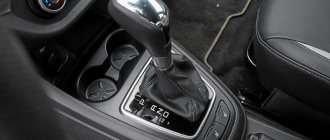08 August 2019 Lada.Online 10 716 4
In the summer, AVTOVAZ presented a new modification of the Lada XRAY Cross. Now this crossover is equipped with the Renault-Nissan H4m alliance engine (1.6 l, 114 hp) and the JF015E continuously variable automatic transmission (hereinafter referred to as “variator” or CVT). We found out how the car turned out during the test drive.
What has changed in the interior?
Xray has acquired a new multimedia system with support for Apple CarPlay and Android Auto. Now you can download Google maps and view not only SMS messages, but also messages in instant messengers. The updated multimedia, by the way, will also appear on Xrays with a manual transmission.
In general, the interior has not changed. Almost. The block of buttons for the heated steering wheel and windshield has moved to the center of the console, since instead of the washer of the Lada Ride Select system, a CVT selector with six quasi-speeds and the possibility of manual switching has appeared. For cars with a CVT, the function of selecting driving modes is not provided, which means you will have to do without it. We'll check whether this will affect the driving behavior - especially off asphalt.
Motor and gearbox are inseparable
The X-Ray Cross hatchback stands apart in the Lada model line. This car was created on the French B0 platform and is very close in design to the Renault Sandero Stepway. They have identical technical parts, the same engines, transmissions, components and chassis. French engineers from the technical center in Moscow worked on fine-tuning both cars. However, they turned out to be different and not close in spirit.
Photo: LADA
Different body design, steering settings, different engine and transmission calibrations, differences in interiors and promotion philosophy place these related cars on opposite sides of the market. Other customers like them, which means they complement each other and satisfy the needs of a larger number of consumers. The CVT produced by Jatco, which, like the Lada brand, is part of the Renault-Nissan alliance, received the same new settings.
In addition, engineers installed a new subframe on the X-Ray Cross, which made it possible to place the automatic transmission higher in the engine compartment, which is why the ground clearance under the X-Ray Cross crankcase now reaches 215 mm.
Photo: LADA
How does it behave off-road?
Xray with a CVT is inferior to versions with manual transmission outside the asphalt. And the point here is not the ground clearance - it just remained large enough. There is a noticeable absence of the control washer of the Lada Ride Select system, which determined the operating mode of the power unit and auxiliary electronic systems. Of course, electronics did not replace all-wheel drive, but it gave an advantage in certain situations by changing the damping of the accelerator pedal and the permissible degree of slipping of the drive wheels. The Xray with a CVT doesn't have all this. The electronics protect the variator and do not allow it to slip as much as you want - even with the traction control system turned off.
You need to understand that the Lada XRAY Cross is a front-wheel drive hatchback with high ground clearance. The car is quite capable of overcoming a snowdrift, a small sand trap and a dirt road where good geometric cross-country ability is important - but nothing more. Therefore, when intending to drive the Lada Xray Cross on muddy ground, in autumn or spring thaw, first think carefully. And take a detour.
About the engine
Renault-Nissan H4m (1.6 l, 114 hp) is already familiar to us, because previously installed on Lada XRAY.
The main distinguishing features of this motor
:
- aluminum cylinder block;
- timing chain drive (no need to replace);
- automatic variable valve timing system, which improves filling of the engine cylinders in all operating modes;
- lack of hydraulic compensators (you will have to adjust the valves every 80 thousand km)
Specifications
:
- Maximum torque - 152Nm/4000rpm
- Maximum speed - 162 km/h
- Acceleration to 100 km/h - 12.8 seconds
- Fuel consumption in the combined cycle - 7.3 l/100km
The HR16DE/H4M engine is also installed on foreign cars: Nissan Note, Nissan Tiida, Nissan Qashqai, Nissan Sentra, Nissan Juke, etc. It has proven itself well among the owners of these cars and is an average engine.
Read more about this motor here.
How much does a Lada XRAY cost with a CVT?
The most affordable Lada XRAY Cross with a CVT will cost 845 thousand rubles, the most expensive - 970 thousand rubles. It turns out that the surcharge for the CVT is reasonable - only 50 thousand. In general, the cost of Xray with CVT is cheaper than Renault from the Stepway line with a similar CVT, as well as Kia Rio X-line and Hyundai Creta. Therefore, if you want a decent car with an automatic transmission, but don’t have the money to buy a Korean car, then the Lada XRAY Cross with a CVT is a suitable option.
5 questions (and answers) about the Lada XRAY Cross with CVT
Two gears for continuously variable transmission
The variator has a very interesting design. Unlike previous generations of Japanese gearboxes, it is equipped with a planetary gearbox with two stages and a reverse mode. The first stage is responsible for low-speed driving in difficult conditions, when climbing mountains or when traveling in mud and snow. In this way, the developers protected the variator from operating modes dangerous for equipment when the belt got into the extreme positions of the pulleys.
Article on the topic
Million dollar car. Test drive LADA Vesta Sport The second stage of the gearbox is designed for fast driving on highways. The pulleys create a wide range of gear ratios, and the second stage makes their operation more economical and efficient. And this is good, especially considering that the box can only handle torque up to 150 Nm. We have to protect it, including using software methods.
The control unit is loaded with programs that help smooth out the shock loads coming from the 113-horsepower French engine. If you stomp on the electronic accelerator pedal and push it into the “kick-down” position, there will be no strong jerk. The control unit will begin to dampen acceleration in such a way that acceleration will be smooth, without peak surges of torque in the transmission. As a result, the dynamics turn out to be bland and uninteresting, although safe for the car and its technical part.
Photo: LADA
Due to the low torque threshold on the new CVT, you need to drive carefully off-road and try to skid less. Although Lada engineers insist that during testing they were not able to overheat the box, because the first stage of the variator works as a “transfer case” and reduces the load, but even it is not able to protect the transmission from extreme slipping in the mud. The metal belt will begin to slip, causing scuffing on the pulleys.
It turned out to be impossible to install the more expensive and larger variator from the Nissan Qashqai on the X-Ray. Although its box can handle 250 Nm of torque, it does not fit into the standard engine subframe on the B0 platform.
Photo: LADA
Old new friend
The Japanese Jatco CVT is well known - it is installed on Renault Stepway and Kaptur. It works in tandem with the Nissan HR16 engine with a volume of 1.6 liters and a power of 113 hp. The most time (about six months) was spent on selecting calibrations: XRAY Cross is heavier, it has wheels of a different size. The variator does not have sports or winter modes - only the ability to manually switch quasi-gears. The power range of gear ratios is the same as that of Renault - from 3.87 to 0.53. The cooling system is integrated into the engine cooling system.
The Nissan HR16 engine with a power of 113 hp is paired with a CVT. Calibrations allow you to pour 92nd gasoline. And Renault demands the 95th.
The Nissan HR16 engine with a power of 113 hp is paired with a CVT. Calibrations allow you to pour 92nd gasoline. And Renault demands the 95th.
The Jatco JF015E variator with a V-belt drive and a two-stage planetary gearbox is well known to us from other models of the concern, primarily from the Renault Stepway series and the front-wheel drive Captur.
The Jatco JF015E variator with a V-belt drive and a two-stage planetary gearbox is well known to us from other models of the concern, primarily from the Renault Stepway series and the front-wheel drive Captur.
You remember that Logan and Sandero Stepway with this CVT lost 20 mm of ground clearance? Vazovtsev was not happy with this arrangement. Even when developing the Cross, whose front suspension differs from that of the regular Xray, they knew that a version with a CVT would appear. Therefore, a different subframe and redesigned engine mounts, which made it possible to maintain a ground clearance of 215 mm. I reached under the bottom with a tape measure and measured 210 mm: close to the truth!
Lada X-ray with a variator is good and not expensive.
We waited. AvtoVAZ has finally released a normal two-pedal Lada. You can remember “Kalinas”, “Grants” and even “Priors” with ancient 4-speed automatic transmissions, but this was archaic even in those days..
Last week we were shown an X-ray cross with a CVT. This is also Jatco and has been on the market for a long time, but is still relevant.
Lada X-ray with CVT
In order to expand the operating range and ensure a confident start, the variator has a reduction gear in a two-stage planetary gearbox , which is especially important for a car with crossover claims and large 17-inch wheels.
We drove the X-ray cross with a CVT onto the nearest overpass, excuse me, I couldn’t wait to look at it from below.
The engine is also almost imported - it is a Nissan 1.6-liter engine with a timing chain drive and one phase shifter. But now it is completely localized. We cast aluminum blocks, make the crankshaft and many other fundamental parts. Thanks to the winged metal, the Japanese engine is noticeably lighter than the Russian one. So, a heavier variator led to a total weight increase of only 13 kg. No suspension retuning was required.
The first VAZ carrier of this power unit was the Lada X-ray Cross. Essentially, this is a Russian take on what Logan could be like.
Lada-XRAY-Cros: 113 “Nissan” forces.
Project manager Oleg Grunenkov recalls that when they received documentation for Sandero, which was supposed to become a platform donor for X-rays, he was very surprised. According to the classics, which are taught in all automotive universities, the track of the front wheels should be equal to or greater than the rear. Then the car is more stable on the road and drives better. For Renault, everything turned out to be the opposite. They began to find out and study the latest discoveries in the industry. But everything turned out to be simpler. Franco-Romanian engineers, when creating the Logan/Sandero family, tried to expand the rear seat and for this purpose increased the rear track, while it was too late to redo the front. They left it that way.
The VAZ team, having barely launched the regular X-ray into production, began to hatch plans for its modification.
X-ray cross with CVT X-ray cross with CVT X-ray cross with CVT
We tried more than 300 variants of the front levers, but still made them longer in order to even out the track a little. At the same time, we brought the run-in shoulder to reasonable values, and the X-ray Cross version drove noticeably better. Not as good as Vesta, but a huge step forward from Renault. By the way, the French themselves carried out a similar modification with Arcana, but this is a separate conversation.
Among other things, the VAZ team has “reflashed” the engine and variator in such a way that now acceleration from zero to “hundreds” takes 12.3 seconds versus 13.8 for the Renault Capture with a similar engine and is a second faster than the Rio X-line.
The Lada X-ray Cross is fine with overclocking.
The maximum speed, however, was only 162 km/h, but on an empty road we managed to reach almost 170, and not according to the speedometer, but precisely according to the GPS.
The drives with the right intermediate support were borrowed from Renault, but otherwise the suspension remained the original “Cross” one. Moreover, the VAZ people say that it is impossible to install a variator in a regular X-Ray, although the original Sandero sells well with it.
But this is all theory; in reality, the CVT X-Ray Cross actually drives well. Although 113 Nissan forces are slightly bogged down by large wheels and high ground clearance, when driving quietly at half-pedal, the X-ray with a CVT differs from the original Sandero in its more diligent character and less vibration. The X-ray with a CVT reacts better to gas and is surprising if you just push it to the floor. The stock under the trigger seemed meatier.
The variator tries its best to imitate the gears. So it is very difficult to feel the gearbox switching, which occurs in the range from 40 to 60 km/h.
Having received a variator, X-ray Cross lost the beautiful electronic mode control washer. And for a two-pedal car it is more relevant than for a manual one. But the thing is that the maximum torque that the variator can handle is only 160 Nm, while the engine produces 152. And the increased loads that an electronic imitation of a front differential lock can create off-road will have a bad effect on the transmission life. For the same reason, the possibility of pairing the variator with the VAZ 1.8 engine is excluded. At peak it produces 170 Nm.
Lada X-ray cross for light off-road use.
So it’s better not to go into serious off-road conditions with a CVT. Moreover, the X-ray Cross with a variator has lost its steel engine protection, and instead there is a gaping hole. The lowest point is still the strut behind the subframe, which eats up a significant portion of the ground clearance.
Oleg Grunenkov knows about this problem and subtly evades it. Under the front bumper the gap is 240 mm, under the engine 215, and see what happens next for yourself. It is not recommended to remove the cross member, although this operation only takes a minute - just unscrew a couple of bolts. The beam is borrowed from the all-wheel drive Duster and adds rigidity to the body. At first you are unlikely to notice its absence, but after driving 150 thousand km, fatigue problems of the body may begin.
Lada X-ray cross with a CVT is a good choice.
By the way, at serious bends our body already creaks slightly. After all, in essence, the Logan/Sandero platform is a passenger chassis, poorly suited for off-road use.
So the main element of the X-ray Cross with a CVT is still asphalt, albeit pretty shabby. The suspension copes well with any potholes, and this makes the Lada stand out from a huge number of Chinese rivals. You can drive down without clearing the road. In addition, we recently jumped on a Lada X-ray from a springboard, and he performed this discipline perfectly.
Why is a CVT more interesting than a full-fledged automatic?
It must be said right away that Russian automatic transmissions turned out to be uncompetitive in their sales area. Today, technology has made great strides towards high-quality adaptation of the gearbox to the driver’s behavior and reliable operation capabilities in any mode. In the Russian robot, everything was the other way around. Today it no longer fits into the technical arsenal of modern cars. It works according to principles that are understandable only to designers, and also very often requires repairs.
In the case of a variator, there are certain advantages:
- it is made in Japan, we all know very well that the Jatco company has never produced low-quality components for the manufacture of machines, it is excellent reliability and high quality;
- the variator is softer and more comfortable than any other transmission options, it interacts well with the driver and easily adapts to any driving modes;
- for a crossover this is the best solution, taking into account the various areas of use of the car; on a bad road you do not have to choose between two possible positions of the gas pedal;
- It is also important that the company did not modify the box specifically for this car, only slightly changing the settings; the modification took place on the engine unit, which became better than before;
- The service life is estimated at 150,000 km - this is the declared resource of the variator, but with careful driving it is quite possible to drive it up to 200,000 km, at the present time this is a good resource.
The most important thing is that the unit will not require any repairs or maintenance during operation. It is enough to inspect the variator at each maintenance, identify possible oil leaks and eliminate their causes. Otherwise, the device does not cause mistrust. This is much cheaper than constantly repairing the Russian robotic box that was previously installed on this machine. It is very interesting that the first reviews of cars with CVTs are much better than those of vehicles with Russian automatic transmissions. This already suggests that you can safely consider the car as a purchase.
No dirt
Reverse speed on Lada is implemented very cleverly. By blocking the satellite of the planetary gearbox, the shaft begins to rotate in the other direction. Such a simple solution allows you to save weight and size of the box. But there is also a drawback. If you frequently switch forward and reverse speeds, the gear change occurs with a delay. The electronics wait until the shafts stop rotating to prevent unwanted loads. Before engaging reverse gear, the box needs to think a little to pump the oil and remove excess torque from the shafts. In general, if you skid in mud or snow, it will be difficult to use the old technique of rocking the body.
Question answer
How does the “Sport” button work on cars and why is it needed? The X-Ray also lost the “Sport” button, which is on the X-Ray with a 1.8-liter engine with a 5-speed manual transmission. This button activates the sport settings of the engine control unit, which could risk increasing peak loads.
The car also does not have a so-called off-road mode, which turns off the traction control and helps overcome small unpaved areas. All this is done in order to protect the variator from breakdowns.
Options and prices
The manufacturer has officially announced prices for the updated version of the Lada XRAY with a CVT. On average, it will cost 50 thousand rubles more than with a manual transmission. The car can be purchased in four trim levels:
- Classic/Optima. The database includes airbags, mounts for child car seats, automatic door locking, alarm system, daytime running lights, ERA-GLONASS, ABS, auxiliary braking system, on-board computer, electric power steering, fabric upholstery, front electric windows, tinting, air conditioning, audio system, 17-inch alloy wheels. The price of the basic version is almost 842 thousand rubles.
- Comfort. This configuration additionally adds rear row headrests, fog lights, a center armrest, power sockets for 12 in the rear, height adjustment for the driver's seat, a heated front seat system, electric mirrors, and rear parking sensors. For these options you will have to pay 43,000 rubles. more.
- Luxe. The luxury version will delight you with fog lights that illuminate the turn, a color dashboard, eco-leather seat upholstery, a leather steering wheel and gear knob, a heated steering wheel and rear seats, cruise control, rain and light sensors. Its cost is 935,000 rubles.
- LuxePrestige. This version is equipped with LED interior lighting, dark tinting of the rear hemisphere, a rear view camera, and a multifunctional multimedia system with a 7-inch display. For such a car you will have to pay about 997 thousand rubles.











